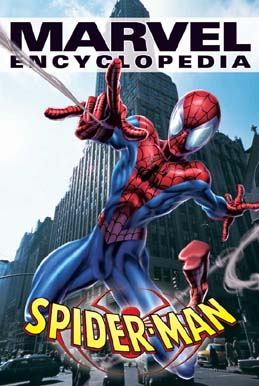Marvel Encyclopedia, v. 4: Spider-Man
Collects: N / A
Released: October 2003 (Marvel)
Format: 240 pages / color / $24.99 / ISBN: 0785113045
Marvel has a reputation for creating excellent reference guides to their characters and stories. The Official Handbook to the Marvel Universe, both in its original and deluxe flavors, are remarkable for their anal-retentive attention to detail and beautiful and informative illustrations. The official indexes to titles such as X-Men, Spider-Man, and Fantastic Four are thorough in their attention to chronology.
 But those were mostly efforts of the ’80s. Now, more than a decade later, Marvel has published Marvel Encyclopedias. Following the format of their recent handbooks on various aspects of the Marvel Universe, the encyclopedias ran six volumes, the last of which was published almost two years ago. (Marvel is now publishing its new OHotMU.)
But those were mostly efforts of the ’80s. Now, more than a decade later, Marvel has published Marvel Encyclopedias. Following the format of their recent handbooks on various aspects of the Marvel Universe, the encyclopedias ran six volumes, the last of which was published almost two years ago. (Marvel is now publishing its new OHotMU.)
Marvel Encyclopedia, v. 4: Spider-Man is a proud descendent of the Marvel reference line. The first 24 pages contain four essays by Kit Kiefer examining Spider-Man in comics, TV, movies, and toys. These essays are missable for someone with much familiarity with Spider-Man, and to a degree, they are already well out of date — the book was published in 2003, when the second Spider-movie wasn’t yet out, the MTV animated series was still on the air, and Spider-Man was still an anonymous Everyman in the comics.
It’s the A-Z reference section in which the encyclopedia pulls its weight. Almost 200 pages of entries, from Annex to Yith, are here. Minor characters are listed three to a page, with more important characters getting more space. Each entry has a brief bio, a picture of the character and explanation of powers, and a list of personal statistics, including first appearance in the comics.
The personal statistics are the least useful part of the entry. Each character is rated on a seven-point scale in six categories. The approximate meaning of each rating is explained at the back of the book, but it seems silly, given the disparity between writers on powers and abilities. It also seems strange to rate Betty Brant, a secretary who worked her way to reporter, and the Silver Surfer, herald of the world-devouring Galactus, on the same scale. The OHotMUDE listed observed parameters, if they seemed relevant. But that would have take up a great deal of room and limited the number of entries. Given those options, the seven-point scales aren’t horrible — just unnecessary.
Because the entries are wonderful. Remarkably concise, each entry manages to give the essence of the character. Researcher Jonathan Couper-Smartt and his contributing writers are to be praised. The entries are great; they often cover far more of the characters’ histories than I would think possible. They are also cross-referenced; characters with entries are denoted with blue text and an underline, making it look like a hyperlink.
I do have a slight problem wit the illustrations used in the entries. First, only the largest illustrations are credited. The three-per-page entries have uncredited illustrations, even though there’s probably room. (At the very least, a credits page at the end would have been appropriate.) Secondly, the larger art tends to favor more recent (as of 2003 artists): John Romita Jr., Tim Sale, Humberto Ramos. Granted, the most recent depictions are probably the most useful for readers. But putting aside Ramos’s suitability for the task (his art is very cartoony for an illustration that’s supposed to be representative), this has the effect of downplaying important early Spider-Man artists, such as Steve Ditko, John Romita Sr., and Gil Kane. Strangely, Gwen Stacy’s entry is done by Tim Sale; you wouldn’t think a character dead 30 years would need recent art. The worst choice was Tim Sale’s recreation of Mary Jane’s “Face it, Tiger — you just hit the jackpot!” first appearance, given the iconic status of John Romita Sr.’s original.
Given the excellence of the entries and the sheer number of them, these are minor complaints, despite the room I gave them. In addition to the entries, there is an appendix with cryptically terse entries on those not notable enough to get a full entry. Top that with an index and a map of New York City with all the important locations numbered, and you’ve got a heck of a package.
To tell the truth, I never would have bought the book had it not been an excellent deal. But I’m glad I did buy it; despite the book being three years out of date, it’s a worthy addition to the bookshelf.
Rating: ![]()
![]()
![]()
![]() (4 of 5)
(4 of 5)
Labels: 4, Jonathan Couper-Smartt, Kit Kiefer, Marvel, Marvel Encyclopedia, Spider-Man




0 Comments:
Post a Comment
<< Home